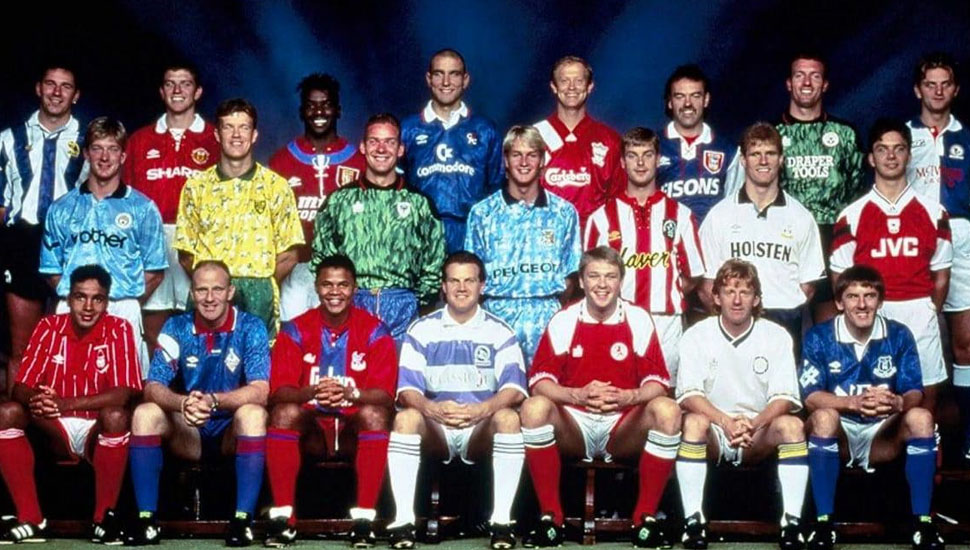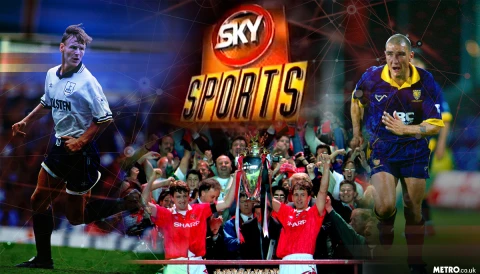The Premier League may seem like it has been going forever, but that is not the case. Any regular viewer of Match of the Day on the BBC will hear presenter, and former world-class striker, Gary Lineker lament about how football in England didn’t exist before the Premier League. That is the power of the branding and the commercial success of the Premier League, and it is why many see it as the best domestic league in the world.
How long has the Premier League been going? The Premier League was founded on 20 February, 1992, supplanting the old English First Division as the top league in England. The inaugural 1992-93 Premier League season was won by Manchester United. As of the 2022-23 season, 50 clubs have competed in the Premier League, with 48 clubs from England joined by Cardiff City and Swansea from Wales. It is the most-watched sports league in the world, with a potential TV audience of nearly 5 billion people each week.

Premier League 1992-93 promo photograph taken ahead of the first Premier League season and featuring a player from every team.
(From left to right, back to front)
- David Hirst (Sheffield Wednesday)
- Lee Sharp (Manchester United)
- Tony Daley (Aston Villa)
- Vinnie Jones (Chelsea)
- Mark Wright (Liverpool)
- John Wark (Ipswich)
- Tim Flowers (Southampton)
- Tim Sherwood (Blackburn Rovers)
- Ian Brightwell (Manchester City)
- Ian Butterworth (Norwich City)
- Hans Segars (Wimbledon)
- Andy Pearce (Coventry City)
- Carl Bradshaw (Sheffield United)
- Gordon Durie (Spurs)
- David Hillier (Arsenal)
- Gary Charles (Nottingham Forest)
- Andy Ritchie (Oldham)
- John Salako (Crystal Palace)
- Andy Sinton (QPR)
- Alan Kernaghan (Middlesbrough)
- Gordon Strachan (Leeds)
- Peter Beardsley (Everton)
The Foundation of the Premier League
To understand why the Premier League began, it is important to know what football was like in England in the 1980s. While the game is thriving today, and while there were English teams (Liverpool as a clear example) able to compete with the top continental teams in the 70s and 80s, the game as a whole was in a terrible way.
Hooliganism was rife in English football, both at home and abroad. At the same time, the infamous Heysel Stadium disaster had seen English clubs banned from European competition for half a decade starting in 1985. This, plus poor wages and a culture that prevented players and teams from reaching their potential, saw top English players like Likeker (Barcelona) and Chris Waddle (Marseille) move to the continent for better money and a better way of life.
The success of the 1990 World Cup, both from the perspective of England’s performance and how lucrative the tournament was to TV stations, was huge. Also important was the publication of the Taylor Report, a paper on stadium standards that would, over time, replace dilapidated inner city stadiums with new all-seater infrastructure that immediately made the game safer and more enjoyable for families.
The Big Five
In 2022 we look at the Premier League as having a “big six.” This may change soon as Newcastle United seems intent on kicking down that door and making it a “big seven” sooner rather than later. It is important to remember when looking at the history of the Premier League, however, that Manchester City and Chelsea were latecomers to the party after massive overseas investments. At the time of the Premier League’s creation, nothing could be done without the support of Liverpool. Manchester United, Tottenham, Arsenal, and Everton.

On the back of the 1990 World Cup success, it was mooted to the top clubs that there was money to be made from football TV rights. Clubs had already begun to shift their operating models to a more businesslike and commercial approach. You only have to look at how long it took sponsorships at even the biggest clubs to transition from a local butcher to global companies to see how far behind the league was in finding direct sources of revenue.
Ironically, a player from a TV company that didn’t end up securing the rights to Premier League matches met with representatives of the “big five” to discuss a breakaway superleague model. Greg Dyke was part of London Weekend Television, a subsidiary of ITV, when he put forward a plan to form the Premier League.
Dyke suggested a league with only the top clubs splitting the TV money instead of the current money that filtered down the football league pyramid. This new league, the Premier League, would be able to negotiate its own TV deal, time slots, and sponsorships and have commercial independence from the rest of the Football League. It was the perfect plan at the perfect time, but not for ITV.
BSkyB Enters The Room
Satellite TV was still a novelty in England in the early 1990s. Sky Television and British Satellite Broadcasting were just encrypted film channels competing. A merger made both stronger, and their Sky Sports channel was launched, carrying rugby, golf, and some European football leagues. What it needed, however, was a killer app. That app was the Premier League.

BSkyB knew that by acquiring the Premier League, they could encrypt their service and move to a monthly subscription model. They were in the right place at the right time, and their £304 million bid for up to 60 matches per year dwarfed the £34 million (up from £18 million pre-Premier League) that ITV bid.
BSkyB knew that to gain subscribers, they had to make the Premier League exclusive. Their deal was done with the BBC getting back Match of the Day, but no other TV company had the rights to live matches. This meant that to watch the new and exciting Premier League, in a world where a dedicated sports channel could do hour-long preview and analysis shows for the first time, you had to have BSkyB.
This combination of TV investment, the hope and newness of a rebranded league, and the business model that the clubs quickly adopted saw the Premier League thrive from the beginning. It is why football before 1992 in England has been pushed to the side, and Gary Lineker is sad every Saturday night.
Premier League Notes
- Winners – There have been seven winners of the Premier League through its first 30 seasons. Manchester United (13), Manchester City (6), Chelsea (5), Arsenal (3), Blackburn Rovers (1), Leicester City (1), and Liverpool (1).
- Gareth Barry is the all-time Premier League appearance record holder with 653 matches. Ryan Giggs (632) and Frank Lampard (609) are the only other two over 600.
- Alan Shearer holds the record with 260 Premier League goals scored. Wayne Rooney had 208, and Harry Kane should get to over 200 this season, barring injury.
- Brian Deane scored the first-ever Premier League goal after five minutes of Sheffield United’s 2-1 win over eventual champions Manchester United on the Premier League’s opening day.
